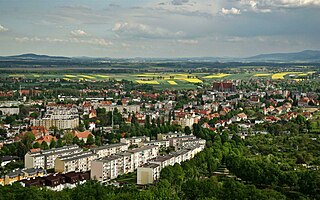
Głogów is a city in western Poland. It is the county seat of Głogów County, in Lower Silesian Voivodeship. Głogów is the sixth largest town in the Voivodeship; its population in 2021 was 65,400. The name of the town derives from głóg, the Polish name for hawthorn.

Lower Silesian Voivodeship in southwestern Poland, is one of the 16 voivodeships (provinces) into which Poland is divided. It covers an area of 19,946 square kilometres (7,701 sq mi), and as of 2019 has a total population of 2,899,986.

The Province of Silesia was a province of Prussia from 1815 to 1919. The Silesia region was part of the Prussian realm since 1742 and established as an official province in 1815, then became part of the German Empire in 1871. In 1919, as part of the Free State of Prussia within Weimar Germany, Silesia was divided into the provinces of Upper Silesia and Lower Silesia. Silesia was reunified briefly from 1 April 1938 to 27 January 1941 as a province of Nazi Germany before being divided back into Upper Silesia and Lower Silesia.

Prudnik is a town in southern Poland, located in the southern part of Opole Voivodeship near the border with the Czech Republic. It is the administrative seat of Prudnik County and Gmina Prudnik. Its population numbers 21,368 inhabitants (2016). Since 2015, Prudnik is a member of the Cittaslow International.

Nowa Sól is a city on the Oder River in Lubusz Voivodeship, western Poland. It is the capital of Nowa Sól County and had a population of 38,763 (2019).

Bielawa is a town in southwestern Poland. Since 1999, it has been situated in Dzierżoniów County, Lower Silesian Voivodeship. From 1975 to 1998, it was part of the Wałbrzych Voivodeship. As of January 1, 2023, it has a population of 28 344.

Dzierżoniów is a town located at the foot of the Owl Mountains in southwestern Poland, within the Lower Silesian Voivodeship. It is the seat of Dzierżoniów County, and of Gmina Dzierżoniów.

Kamienna Góra is a town in south-western Poland with 18,235 inhabitants (2023). It is the seat of Kamienna Góra County, and also of the rural district called Gmina Kamienna Góra, although it is not part of the territory of the latter.

Polkowice is a town in south-western Poland. It is situated in Lower Silesian Voivodeship. The town is the seat of Polkowice County and of Gmina Polkowice.

Ząbkowice Śląskie is a town in Lower Silesian Voivodeship, in south-western Poland. It is the seat of Ząbkowice Śląskie County and of a local municipality called Gmina Ząbkowice Śląskie. The town lies approximately 63 kilometres south of the regional capital Wrocław. As of 2019, it had a population of 15,004.

Strzegom is a town in Świdnica County, Lower Silesian Voivodeship, in south-western Poland. It is the seat of the Gmina Strzegom administrative district (gmina). It lies approximately 15 kilometres (9 mi) north-west of Świdnica, and 52 kilometres (32 mi) west of the regional capital Wrocław.

Namysłów is a historic town in southern Poland, within Opole Voivodeship. Located along the Widawa River, it is the capital of Namysłów County. Its population was 16,551 in 2019.

Niemcza is a town in Dzierżoniów County, Lower Silesian Voivodeship, in south-western Poland. It is the seat of the administrative district (gmina) called Gmina Niemcza.

Głuchołazy is a historic town in southwestern Poland with approximately 13,534 inhabitants as of 2019. It is located within the Nysa County of Opole Voivodeship (province), near the border with the Czech Republic, and is the administrative seat of Gmina Głuchołazy.

Iłowa is a town in Żagań County, in Lubusz Voivodeship, in western Poland, the administrative seat of the Gmina Iłowa.

Chocianów is a town in Polkowice County, Lower Silesian Voivodeship, in south-western Poland. It is the seat of the administrative district (gmina) called Gmina Chocianów. The town lies approximately 14 kilometres (9 mi) south-west of Polkowice, and 85 kilometres (53 mi) west of the regional capital Wrocław. As of December 2021, it has a population of 7,869.

Bolków is a town in Jawor County, Lower Silesian Voivodeship, in south-western Poland. It is the seat of the administrative district (gmina) called Gmina Bolków and part of the Neisse-Nysa-Nisa Euroregion.

Ścinawka Średnia is a village in the administrative district of Gmina Radków, within Kłodzko County, Lower Silesian Voivodeship, in south-western Poland.

Giebułtów is a village in the administrative district of Gmina Mirsk within Lwówek Śląski County, Lower Silesian Voivodeship, in south-western Poland, close to the Czech border. Giebułtów lies approximately 3 kilometres (2 mi) north-west of Mirsk, 23 km (14 mi) south-west of Lwówek Śląski, and 120 km (75 mi) west of the regional capital Wrocław.

Kłodzko Land is a historical region in southwestern Poland.




























